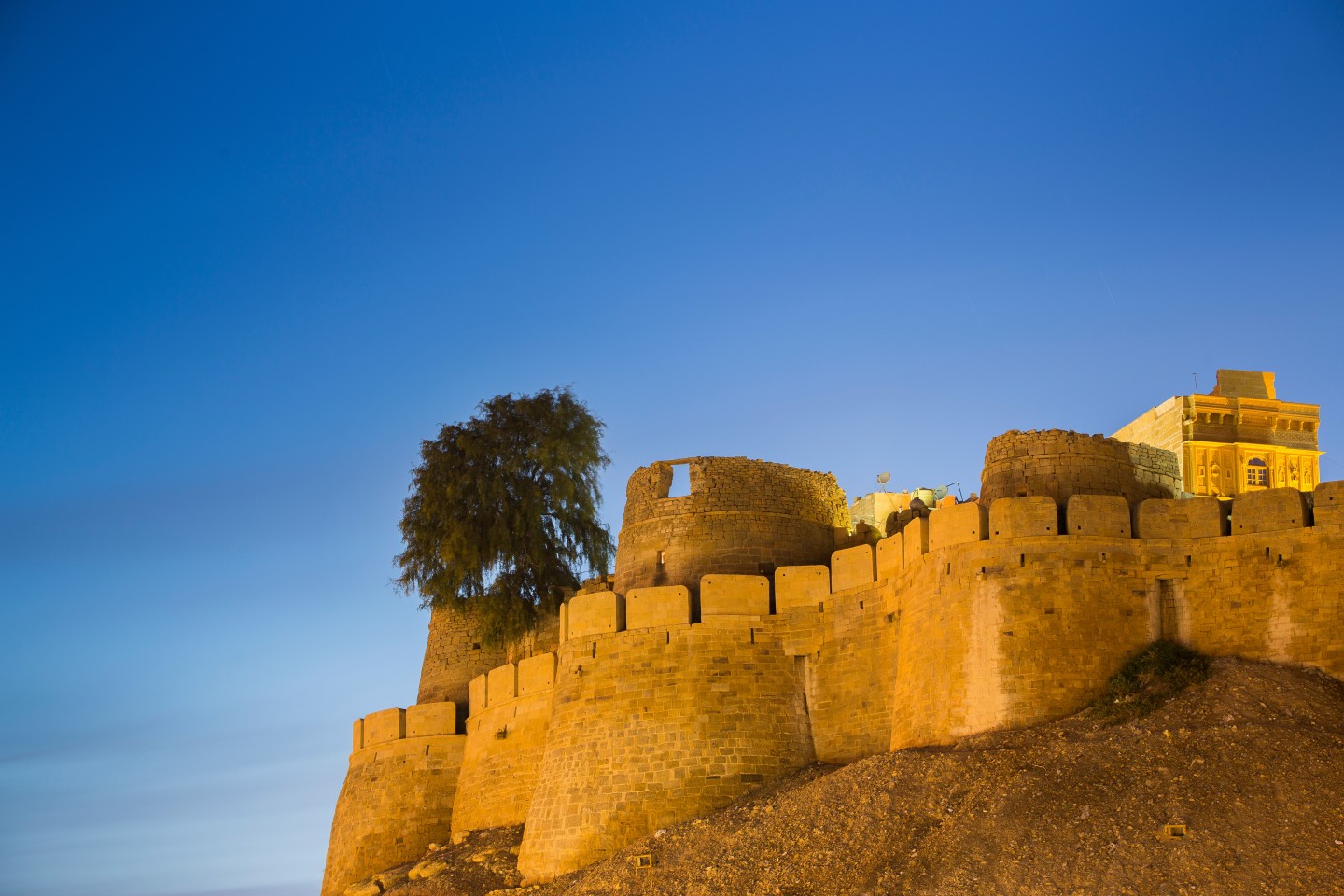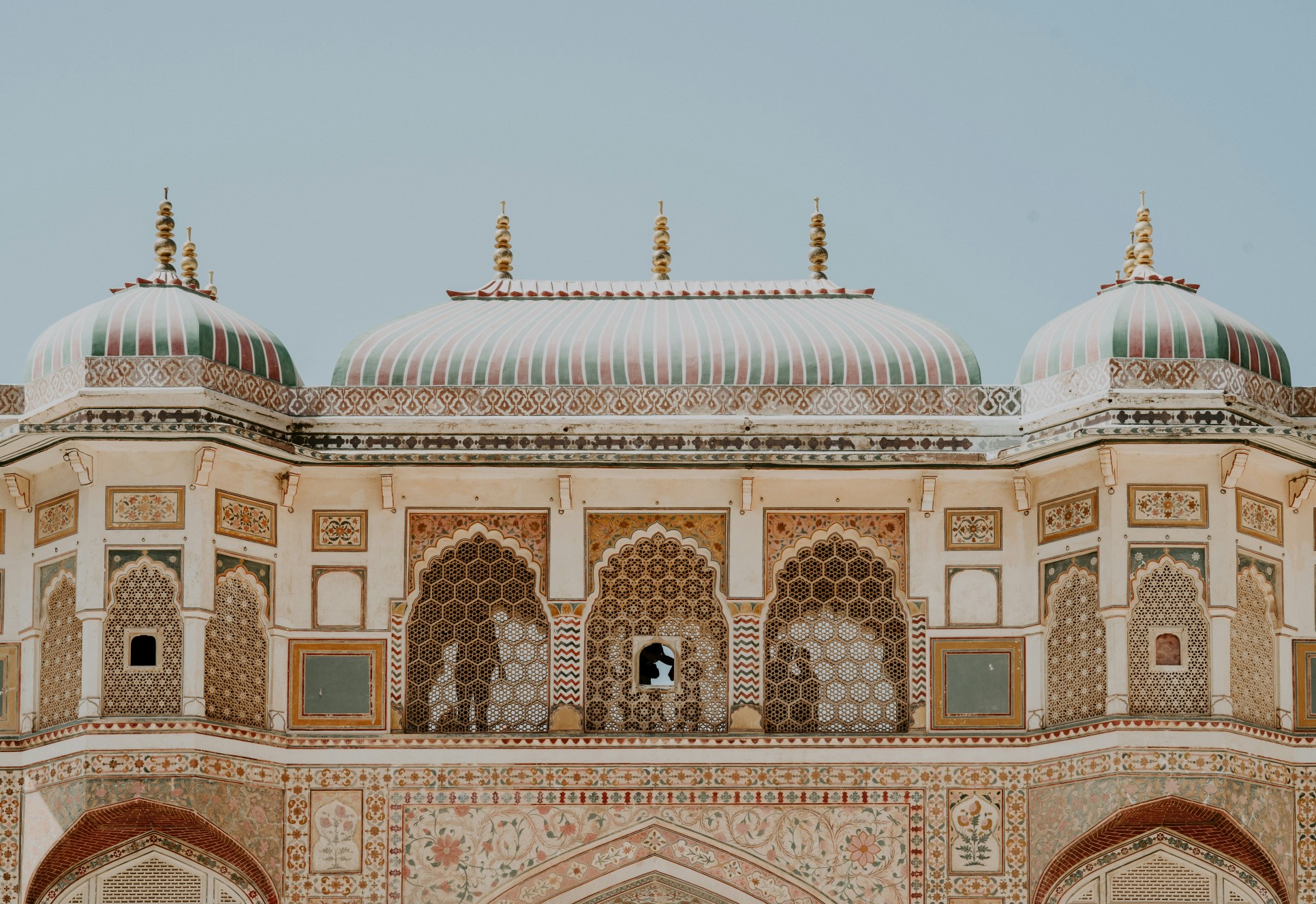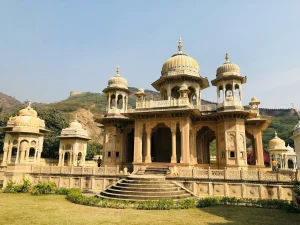The Pink City’s Shadow: An Introduction
Jaipur, the capital of Rajasthan, is a beautiful city known around the world for its beautiful buildings, lively culture, and long history of royalty. The “Pink City” is famous for its pink buildings. It is home to grand forts, luxurious palaces, and busy markets that celebrate life. But there is a strange parallel universe hidden behind this bright, sunny surface. It is full of creepy legends, scary places, and ghost stories that locals and brave tourists tell each other.
This guide will take you on a deep dive into the scary and interesting world of the paranormal in Jaipur. We’ll look into the stories and try to find out what’s true about these places, from the most cursed fort in India to the creepy royal tombs that are best left alone at night. This is the part of Jaipur that doesn’t always make it into travel brochures. It’s where history, folklore, and the strange come together.
The Tarzan Way’s immersive storytelling journeys bring this strange and spooky side of Rajasthan to life. Here, every shadow has a story and every ruin holds a secret.
Are you ready to meet the ghosts of the Pink City?
Key Takeaways
- India’s Most Haunted: Learn about the scary story of Bhangarh Fort, which is so haunted that the government won’t let anyone in after dark.
- The Royal Ghost: Find out about Nahargarh Fort and the ghost of a prince who still walks its walls, watching over the city he loves.
- Local Legends: Find out about the creepy stories about Jagatpura Road, which is said to be haunted by witches, and the Delhi-Jaipur Highway.
- Eerie Architecture: Visit Chand Baori, the old stepwell that is said to have been built by ghosts in one night, and Gaitore Ki Chhatriyan, the royal cenotaphs that seem to have a heavy, watchful presence.
- Myth vs. Reality: We set the record straight about Jal Mahal by separating real history from scary stories.
- Responsible Dark Tourism: Find out how to visit these “haunted” places in a way that is respectful, safe, and doesn’t offend the local culture.
01. The Strange Mystery of Bhangarh Fort in India
 Bhangarh Fort ruins in Rajasthan, known for its haunted legends.
Bhangarh Fort ruins in Rajasthan, known for its haunted legends.
Bhangarh Fort is one of the most famous haunted places in India, and it is also one of the most famous in Jaipur. This 17th-century fort is about 85 km from Jaipur in the Sariska Tiger Reserve. It is a place of undeniable beauty and bone-chilling terror. Its fame is so great that the Archaeological Survey of India (ASI) has put up a permanent, official sign at the entrance that says visitors are not allowed to stay on the property after sunset and before sunrise.
The Story of Princess Ratnavati and the Tantric
The main story is about Princess Ratnavati, who was known for her beauty and was said to be the jewel of Rajasthan. A local black magician named Singhia became very interested in her. He knew he didn’t have a chance, so he bewitched a bottle of perfume she was going to buy and cast a spell on her to make her love him.
The princess, on the other hand, saw him do it and threw the bottle, which broke against a big rock. The enchanted boulder rolled towards Singhia and crushed him. The tantric cursed the whole fort and the villages around it as he died, saying that they would be destroyed and left alone forever, with no one ever being reborn there. A war soon after destroyed the fort and killed everyone inside, leaving it an empty, haunted shell.
Advice for Travellers
- Go During the Day: This is an ASI rule that you can’t break, and it’s also for your own safety because the area is a tiger reserve. The ruins are big and pretty during the day.
- It’s a day trip, so plan on driving two hours each way from Jaipur. You can go to Chand Baori in Abhaneri at the same time.
- Follow the rules: Don’t try to stay after dark. This rule is very important to both locals and officials.
Quick Facts
- Location: Gola ka Baas, Alwar District (close to Sariska)
- Built in the 17th century
- Status: ASI Protected; known as “The Most Haunted Place in India”
- The Vibe: A deep, unsettling silence and a strong sense of tragedy.
02. Nahargarh Fort: Where the Legend of the Royals Lives On

Nahargarh Fort, which is on the rugged Aravalli Hills above the Pink City, has the best view of Jaipur from all angles. It’s the best place in the city to watch the sun set. But the fort changes when the sun goes down and the city lights come on. It turns into a place where the line between the real and the unreal becomes less clear.
The Story of Nahar Singh Bhomia
The ghost of Nahar Singh Bhomia, a Rathore prince, is connected to the fort’s creepy past. He owned this land at first, and he didn’t like it when a fort was built on it. Whatever was built during the day would mysteriously fall apart at night. The fort’s builder, Maharaja Sawai Jai Singh II, knew that a restless spirit was getting in the way of the work.
The Maharaja built a small fortress (a haveli) inside the main fort and dedicated it to Nahar Singh Bhomia to calm the prince’s spirit. The haunting was said to have stopped, but stories say that his spirit never left. People now think of him as the fort’s guardian, but he still lets people know he’s there.
Advice for Travellers
- The best time to visit is at sunset. You can see the beautiful views and feel the “vibe” change as night falls.
- Be Respectful: The Nahar Singh temple is still a place of worship. Act appropriately.
- The Wax Museum: The fort now has a restaurant and a wax museum, which makes it a great place for tourists to visit.
Quick Facts
- Location: With a view of Jaipur city
- Built in 1734
- The ghost of Prince Nahar Singh Bhomia is the resident spirit.
- The Vibe: Majestic during the day and creepy and watchful at night.
03. The Witches of Jaipur live on Jagatpura Road

Jagatpura is a busy residential and commercial area in modern Jaipur, unlike the grand forts. It isn’t a tourist spot, but it is the setting for one of Jaipur’s scariest urban legends. People in the area talk about the road that goes through here and say it’s one of the most haunted parts of the city.
The Witch’s Tale
The story of Jagatpura isn’t about just one ghost; it’s about many. It’s a classic “woman in white” story, but with a scary twist. People who live in the area and people who travel late at night say they saw a woman in a traditional white dress asking for a ride or help. People who stop are either scared by her sudden, horrible change or hear crazy laughter as she disappears.
There are also stories about a group of witches (chudails) that are said to show up on the road late at night, especially between 2 and 3 AM, to do rituals. Some reports talk about cars breaking down suddenly, temperatures dropping without explanation, and a strong feeling of a bad presence.
Advice for Travellers
- This is not a tourist spot; it’s an urban legend about a public road in a residential area. During the day, there isn’t much to “see” here.
- Be safe and respectful: Don’t go “ghost hunting” here. It is not safe to walk down unknown roads at night, and it is also disrespectful to the people who live there.
- The Vibe: A modern urban legend that is very real to the people who live there.
Quick Facts
- Jagatpura district, Jaipur, is where it is.
- Type: Urban Legend / Haunted Road
- Important People: A “woman in white” and a group of witches
- The Vibe: Scary things that happen in the present day.
04. Chand Baori (Abhaneri): The Ghosts’ Maze
The village of Abhaneri is about 95 km from Jaipur and on the way to Agra. Chand Baori, one of the world’s oldest, deepest, and most beautiful stepwells, is located here. This baori was built in the 9th century and is a geometric wonder. It has 3,500 perfectly symmetrical steps that cross each other and go down 13 stories (100 feet) into the ground. It has an eerie feel because it is so big and underground.
The Story of the Ghost Builders
The most well-known story about Chand Baori is that ghosts (bhuts) built it in one night. People who live there say that its 3,500 steps are so many and hard that people couldn’t have finished it so quickly.
Another story says that the steps make an impossible maze: if you walk down to the bottom, you can never climb back up the same stairs. People say that the deep, dark, and often cool bottom of the well, where the water used to collect, is a place where spirits gather. Visitors have said they heard whispers and felt a cold, unseen presence.
Advice for Travellers
- Abhaneri is not too far from Bhangarh Fort, so you can visit both in one long but rewarding day trip from Jaipur.
- Photography: This is a photographer’s dream come true. The way the light and shadow play on the geometric steps is amazing.
- Safety: You can’t walk down the steps anymore for safety reasons, but you can still explore the upper levels and cloisters.
Quick Facts
- Where: the village of Abhaneri
- Built in the 9th century
- Key Legend: Ghosts built it in one night; it’s a maze that can’t be climbed.
- The Vibe: Old, awe-inspiring, and very disturbing.
05. The Dudu Ghost on the Delhi-Jaipur Highway (NH-48)
This is another well-known haunted road, and it runs along a certain part of the national highway that connects Delhi and Jaipur. The part near the village of Dudu is home to a famous ghost story that has scared truckers and drivers at night for years.
The Story of the Accident Victim
People say that a long time ago, a woman and her child died in a terrible car crash right here. Her spirit is stuck and now haunts the highway. Drivers have said that a woman in a red sari suddenly appeared in the middle of the road, sometimes with a baby in her arms, making them swerve violently. Some people say that she will run next to their car, keeping up with it, and then vanish.
Advice for Travellers
- This is a busy highway. It’s very dangerous. This story is just a myth, and the best way to “experience” it is to read about it, not to look for it.
- The Vibe: A classic “woman in white” (or red, in this case) ghost on the road.
Quick Facts
- Location: On NH-48 (Delhi-Jaipur Highway), not far from Dudu
- Type: Road that is haunted or has stories about it
- Key Figure: The spirit of a woman who died in a car crash.
06. A Colonial Ghost Story at Ramgarh Bungalow (Hotel)
The Ramgarh Bungalow is a piece of history from the colonial era that stands out in the middle of Jaipur’s modern bustle. This historic building was once a hunting lodge for British officers, and it has seen the wealth and luxury of that time. But like many old colonial buildings, it has a dark, ghostly side that comes with its historical charm.
The Story of the Officer’s Wife
People in the area say that the bungalow is haunted by the wife of a British officer. The story goes that she died in the bungalow because she was so sad about the death of her child. People say that her spirit now roams the old hallways, and her cries of sadness and the sound of crying can be heard all night. People who have stayed the night have said they felt unexplained chills, saw shadowy figures for a short time, and felt a definite sadness in the air.
Travel Tips
- You Can Stay Here: This hotel is a historic one. It has the “haunted hotel” experience for brave travellers, which mixes history with a scary thrill.
- The mood is sad, old-fashioned, and creepy.
Quick Facts
- Jaipur is the place.
- Type: Ghost story about a haunted hotel or a colonial ghost
- Resident Spirit: The wife of a British officer who is sad.
07. Gaitore Ki Chhatriyan: The Royal Spirits That Watch Over Us
 Gaitore Ki Chhatriyan: The Royal Spirits That Watch Over Us
Gaitore Ki Chhatriyan: The Royal Spirits That Watch Over Us
The Kachhwaha Rajput dynasty (the founders of Jaipur) used Gaitore Ki Chhatriyan as their royal cremation ground. This site is a beautiful, open-air gallery of intricately carved cenotaphs (chhatris) dedicated to the city’s Maharajas. It is hidden away in a quiet valley at the foot of Nahargarh Fort.
It is a place of the dead, even though it is very beautiful. People don’t usually think of “jump-scare” ghosts when they think of this place, but they do think of something that makes them feel more uneasy: a heavy, watchful, and sombre atmosphere. People who visit, especially those who stay until dark, say they feel like they are being watched by unseen eyes from the royal tombs. People often hear footsteps on gravel and soft whispers.
Travel tips
- Go in the late afternoon: The light on the marble cenotaphs is lovely, and you can feel the mood change as the sun sets and people leave.
- Be polite: This is not a theme park; it is a royal cremation site. Act with the most respect and politeness.
- The Vibe: Not scary, but very creepy, sad, and watchful.
Quick Facts
- Where: Jaipur (close to the walled city)
- Type: Royal Cenotaphs
- Key Legend: A lot of royal spirits are around.
Bonus: Proving that the Jal Mahal (Water Palace) myth is false

As you said in your first draft, the Jal Mahal (Water Palace) is often on “haunted” lists. This is a great example of how mystery and the paranormal can get mixed up.
The Myth: The Jal Mahal is a five-story palace, and four of its floors are under the water of Man Sagar Lake. People have heard rumours of haunted underwater chambers and restless spirits trapped below because of this “submerged secret.”
The Truth (EEAT): The Jal Mahal is not a haunted house; it is an architectural wonder. Maharaja Madho Singh I built it as a hunting lodge and a place to have fun with duck shoots, not as a place to live all the time. The lower floors were meant to be underwater. It had been in bad shape for hundreds of years, but it was beautifully restored. Today, it is a protected monument, and the public can’t get in. The fact that it is hard to get to and has a unique design makes it mysterious, not any ghost stories that have been written down. It is not a scary place; it is a beautiful and amazing place.
Extra: A Guide to Responsible Dark Tourism
“Dark Tourism,” which is going to places linked to tragedy or the supernatural, needs a lot of respect.
- Follow All Rules: The ASI sign at Bhangarh is not a suggestion; it’s a law. This is to protect your safety (from wild animals) and to honour the site’s sacredness.
- Respect the Living: Don’t go into Jagatpura or bother the people who live there. These are people’s homes, not a show.
- Respect the Dead: Keep in mind that Gaitore Ki Chhatriyan is a place where people are cremated. Don’t be loud, dress modestly, and don’t cause trouble.
- Know that these are local legends and not facts. Have fun with the stories, but don’t think of them as a “ghost hunt.”
The Tarzan Way is dedicated to telling stories in a way that is respectful and immersive, making sure that even when they look at the “dark side,” they do so with cultural sensitivity.
FAQs
Q: Where in Jaipur is the most haunted place?
A: Bhangarh Fort is definitely the most haunted place in all of India, not just the Jaipur area. But it’s a two-hour drive from the city. The most famous and well-known story about a place in the city is about the Nahargarh Fort.
Q: Why is Bhangarh Fort really closed at night?
A: There are two main reasons. 1) The ASI respects the strong and widespread legends. 2) The fort is in the Sariska Tiger Reserve, and being there at night is very dangerous because there are wild animals like tigers and leopards.
Q: Is it safe to go to these haunted places?
A: Yes, during the day. Bhangarh, Nahargarh, Chand Baori, and Gaitore are all safe, beautiful, and interesting historical places to visit during the day. At night, it’s not safe to go to them or the haunted roads.
Q: Is it possible to stay in a haunted place in Jaipur?
A: Yes, the Ramgarh Bungalow is a historic hotel that is said to be haunted, so brave travellers can stay there and have a “haunted hotel” experience.
Q: Are the tales about Jagatpura and the road true?
A: These are classic stories from cities and towns. They are a very real part of the local culture and beliefs, but they are not “events” that can be proven.
Glossary
- Tantric: A person who practices Tantra, a secret tradition that is sometimes linked to mystical, magical, or occult rituals.
- Haveli: A traditional mansion in Rajasthan or North India that is often important for its history or architecture.
- Chhatri: A dome-shaped pavilion or cenotaph that is a common feature of Rajasthani architecture and is used to mark places where people are cremated.
- Baori: A stepwell from India. A big well or pond with steps going down to the water level. People often use it to get water and to meet up with friends.
- The Archaeological Survey of India (ASI) is the government agency in charge of keeping and protecting historical sites.
Conclusion: Getting to the Bottom of the Paranormal
Jaipur’s Pink City is a place with two sides. For every grand palace that celebrates life, there is a quiet ruin that tells of its end. There is a story to tell on every quiet, empty stretch of road, just like there is on every busy, colourful bazaar. These haunted places, which are full of history and folklore, give the city a dark, interesting, and complicated layer of identity.
They encourage you to go into the unknown and discover the depths of history and the human mind. These stories won’t go away, no matter if you believe in the supernatural or are just curious. Take a moment to look at the shadows as you walk through Jaipur. They remind us that even in the brightest cities, there will always be mysteries.
Are you ready to see the scary side of the Pink City? The Tarzan Way (TTW) can help you plan the perfect unusual trip that includes chills, history, and stories you’ll never forget. If you dare, book your haunted Jaipur adventure.






